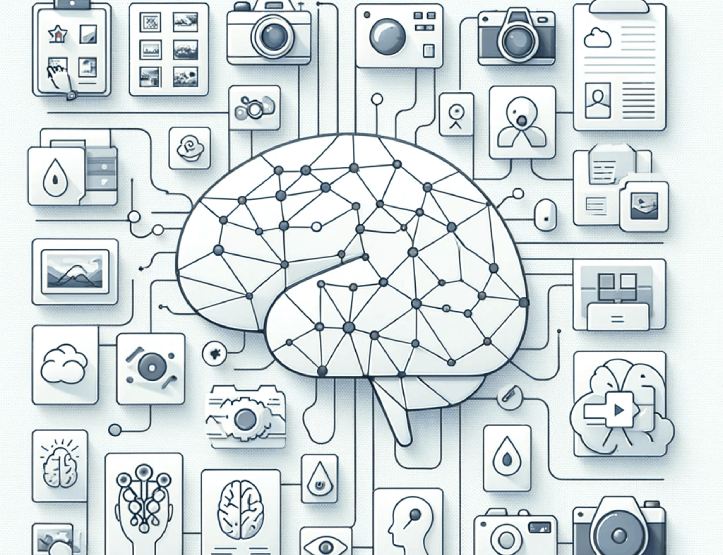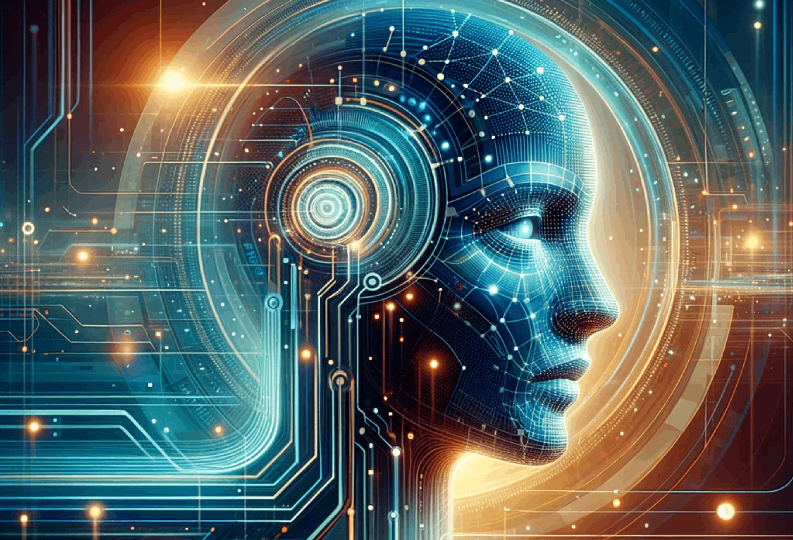Discover how artificial intelligence is revolutionizing image classification solutions.
Visual Data: The Role of AI in Enhancing Image Classification
Solution
Visual data plays a crucial role in today’s digital age, where images are a significant part of our day-to-day lives. From social media posts to medical scans, the ability to classify and understand visual data is essential for various industries and applications. No wonder the global visualization software market is forecast to grow. According to a report by Lionel Sujay Vailshery, in 2019, the market’s value was 1.63 billion U.S. dollars. In 2030, this number will reach 9.61 billion U.S. dollars.
With the advancements in artificial intelligence (AI), image classification has reached new heights in accuracy and efficiency. In this article, we will explore the basics of visual data, the science behind image classification, the concept of artificial intelligence, and how AI enhances image classification. We will also discuss the future of AI in image classification and the potential challenges and solutions that lie ahead.
Understanding the Basics of Visual Data
Before diving into the world of AI and image classification, it is crucial to understand the basics of visual data. Visual data refers to any form of information that is represented visually, primarily through images or videos. From a technical perspective, visual data consists of pixels, which are tiny dots that form an image on a digital screen. Each pixel contains information about the color and intensity of light it represents.

Importance of Visual Data in Today’s Digital Age
In today’s digital age, the importance of visual data cannot be overstated. With the messages buzzing around, everyone seeks the most effective ways to tell a word about themselves. And most often, this word is said … via a picture. According to an MIT report, a human brain can process an image in just 13 milliseconds. This refers to complex images, such as “a smiling couple” or “a picnic.” At the same time, an average human brain needs about 100–200 milliseconds to read a word and 300–400 milliseconds to read a sentence. No wonder, professional advertising relies heavily on visual presentation.
Use case: The Search Engine Journal presents their experiment on how people interacted with Google’s search results page before and after Google included images and videos in search results. As seen in the picture, previously, with no images, the most attention was paid to the first three search results, which is natural. Yet, after Google included images and videos into search results, the attention of visitors shifted towards them. Here’s an example of a serach results page before images:

Image: Google’s Search Results Page with Text Only, Source: Search Engine Journal
And now, here’s what happened as Google added videos to their search reult pages. As we see from the heatmap, video’s have stole atention from the search result ranking first.

Image: Google’s Search Results Page with Videos, Source: Search Engine Journal
The same happened as images were added to search results.

Image: Google’s Search Results Page with Images, Source: Search Engine Journal
As we see, visual information is more appealing to internet users and drives more traffic.
Visual data also plays a vital role in fields such as healthcare, where medical images are used to diagnose and treat patients. Furthermore, visual data is an integral part of industries such as autonomous vehicles, surveillance systems, and remote sensing, where accurate and real-time image classification is crucial.
Visual data is not only essential for communication and information sharing but also for enhancing user experiences in various applications. For instance, in the field of virtual reality (VR) and augmented reality (AR), visual data is the cornerstone of creating immersive and interactive environments. By capturing and processing visual data in real-time, VR and AR applications can provide users with a sense of presence in virtual worlds, blurring the line between the physical and digital realms.
Moreover, visual data analysis plays a significant role in understanding human behavior and preferences. Through techniques like facial recognition and eye tracking, researchers and marketers can gather valuable insights into how people interact with visual stimuli. This information is crucial for designing user-friendly interfaces, personalized advertising campaigns, and improving overall customer experiences.
As technology continues to advance, the importance of visual data will only grow, shaping the way we interact with machines, consume information, and perceive the world around us.
The Science Behind Image Classification
Image classification is the process of categorizing images into predefined classes or labels. It is a fundamental task in computer vision that has seen significant advancements with the integration of AI techniques. By understanding the science behind image classification, we can better appreciate how AI enhances this process.
What is Image Classification?
Image classification is a supervised learning technique, where a machine learning algorithm is trained on a labeled dataset to recognize and categorize images. The algorithm learns to extract meaningful features from the images and uses these features to assign a label to any new unlabeled image it encounters. The accuracy of image classification depends on the quality and diversity of the training data, as well as the effectiveness of the chosen algorithm.
The Process of Image Classification
The process of image classification involves several steps. First, a training dataset consisting of labeled images is prepared. These labels represent the classes or categories that the algorithm will learn to recognize. Next, the algorithm is trained using various techniques, such as convolutional neural networks (CNNs), which are specialized architectures for image processing. The training phase involves feeding the algorithm with the labeled images and adjusting its parameters to minimize the classification errors. Once trained, the algorithm can classify new, unseen images accurately.
Introduction to Artificial Intelligence
Artificial intelligence, often referred to as AI, is a branch of computer science that focuses on creating intelligent machines capable of performing tasks that typically require human intelligence. AI systems can learn from and adapt to data, make decisions, solve problems, and even communicate or interact with humans. The concept of AI has been around for decades, but recent advancements in computing power and the availability of vast amounts of data have propelled AI to new heights.
The Concept of Artificial Intelligence
The concept of artificial intelligence revolves around creating machines that can mimic or simulate human intelligence. This includes the ability to reason, learn, perceive, understand language, and make logical decisions. AI systems can be either rule-based, where they follow predefined rules, or machine learning-based, where they learn from data to improve their performance over time. The goal of AI is to create intelligent machines that can adapt and solve complex problems efficiently.
Want to learn more about the role of data in training artificial intelligence algorithms?
Find plenty of interesting insights in our article: Balancing Algorithms and Data.
The Evolution of AI Technology
AI technology has come a long way since its inception. Initially, AI systems were limited to basic rule-based approaches that required explicit programming of rules to solve specific tasks. However, with the advent of machine learning, AI systems became more flexible and capable of learning from data. This led to breakthroughs in areas such as speech recognition, natural language processing, and image classification. Today, AI systems powered by deep learning, a subfield of machine learning, have achieved remarkable performance in various tasks, including image classification.
AI and Image Classification: A Powerful Combination
The combination of AI and image classification has revolutionized the way we analyze and process visual data. AI techniques, particularly deep learning, have significantly enhanced the accuracy and efficiency of image classification algorithms. By leveraging vast amounts of training data and powerful computational resources, AI systems can extract intricate features from images, making them capable of recognizing patterns and objects with remarkable accuracy.
How AI Enhances Image Classification
AI enhances image classification by automating the process and improving its accuracy. Traditional image classification algorithms rely on manually engineered features, which can be time-consuming and limited in their ability to capture complex patterns. AI systems, on the other hand, learn the relevant features directly from the data, eliminating the need for manual feature engineering. This allows AI-powered image classification algorithms to adapt to different image domains and consistently improve their performance with more training data.
The Impact of AI on Image Classification Accuracy
The impact of AI on image classification accuracy has been profound. AI-powered image classification algorithms consistently outperform traditional algorithms in terms of both accuracy and scalability. By leveraging deep learning techniques, AI systems can learn intricate features from images that were previously challenging to capture. This has opened up new opportunities in various industries and applications, including healthcare, autonomous vehicles, and security systems.
The Future of AI in Image Classification
The future of AI in image classification looks promising. As AI technology continues to evolve, we can expect further advancements in image classification accuracy, efficiency, and robustness. AI algorithms will become more adaptable to different image domains, allowing for more accurate and context-aware image classification. Furthermore, advancements in hardware, such as specialized AI chips, will enable real-time image classification on edge devices, making AI-powered image classification more accessible and pervasive.

Predicted Developments in AI and Image Classification
In the coming years, we can expect AI and image classification to evolve in various ways. One area of focus will be improving the interpretability of AI-driven image classification algorithms. Researchers are working on techniques to make AI systems explainable, making it easier for humans to understand the reasoning behind their classifications. Additionally, advancements in transfer learning, a technique that allows AI models to leverage knowledge from one image domain to another, will enable more efficient and accurate image classification, even with limited training data.
Potential Challenges and Solutions in AI-Enhanced Image Classification
While AI-enhanced image classification holds immense potential, it also presents challenges that need to be addressed. One such challenge is the lack of transparency and accountability in AI decision-making. To overcome this, researchers are exploring methods for making AI systems more transparent and providing explanations for their classifications. Another challenge is the bias that can be present in training data, which can lead to biased or unfair image classifications. Developing robust techniques to mitigate bias and ensure ethical image classification will be crucial for the widespread adoption of AI in this domain.
Conclusion
In conclusion, visual data plays a pivotal role in today’s digital age, and image classification is a key process for understanding and categorizing this data. With the integration of AI techniques, image classification has reached new heights of accuracy and efficiency. AI-powered algorithms can learn intricate features directly from data, improving the accuracy and adaptability of image classification systems. The future of AI in image classification looks promising, with advancements predicted in interpretability, transfer learning, and real-time classification. However, it is important to address challenges such as transparency and bias to ensure ethical and fair image classification. As AI continues to advance, the role of AI in enhancing image classification solutions will only become more critical in various industries and applications.

Have an idea for an AI solution based on image recognition?
Contact eNest for a consultation and advice. Our team will be happy to help you with a timeline and cost calculation, as well as discuss what you need to do to start with your project. Book your free meeting now!
Have a question?
Speak to Data Scientist
 Jagdeep Chawla
Jagdeep ChawlaMS in Data Science
NorthWestern Univeristy, Illinois
MS in Data Science
NorthWestern Univeristy, Illinois




